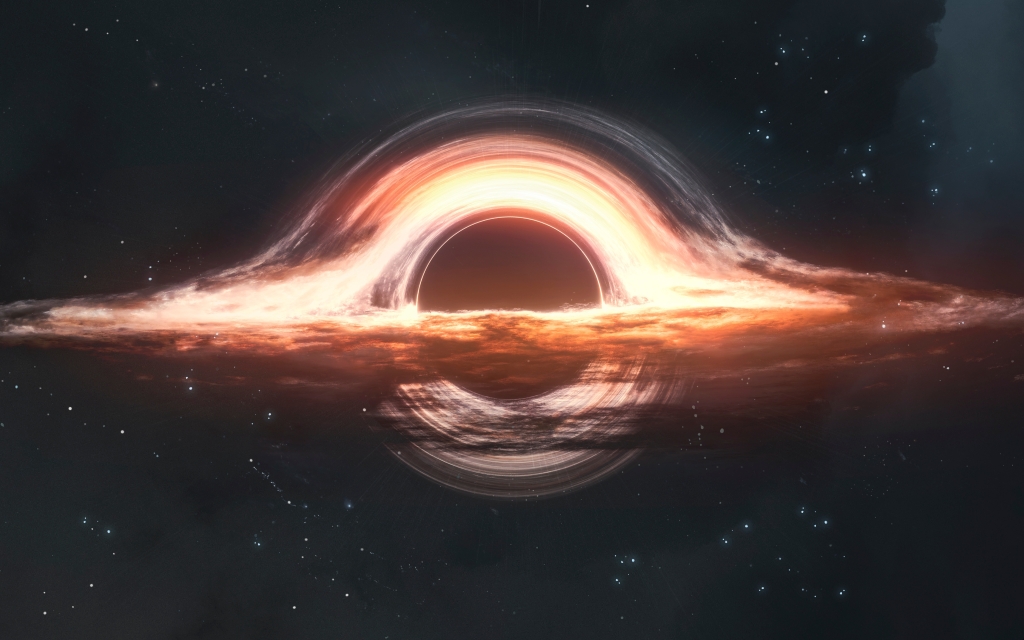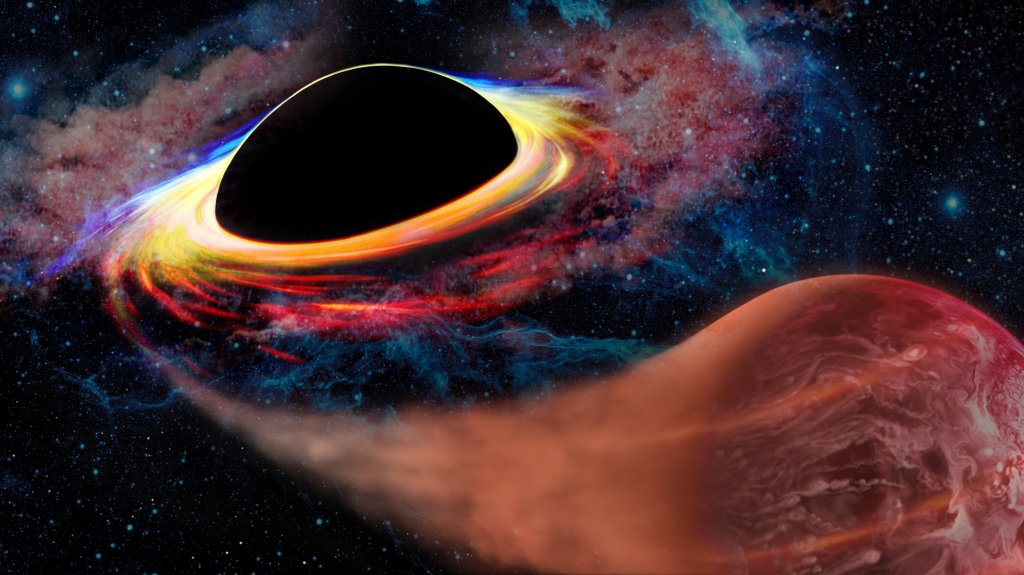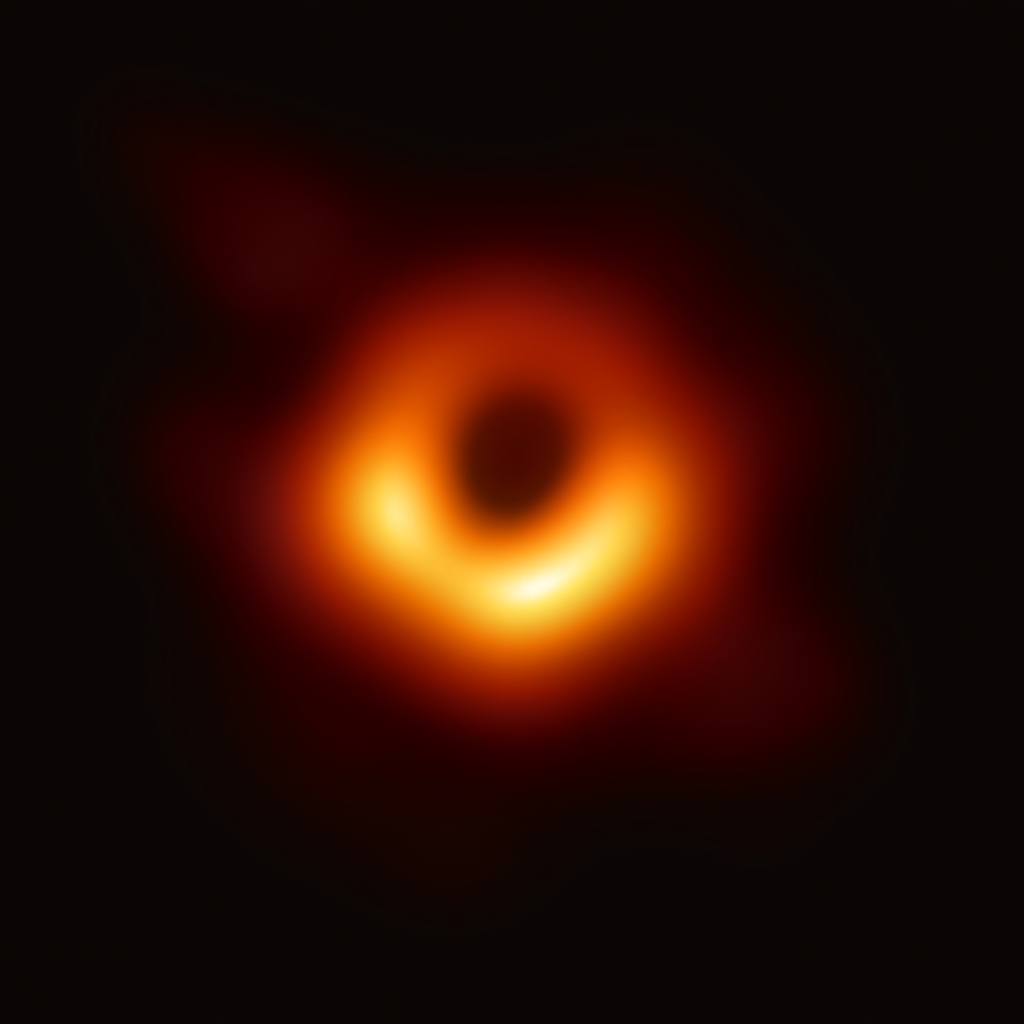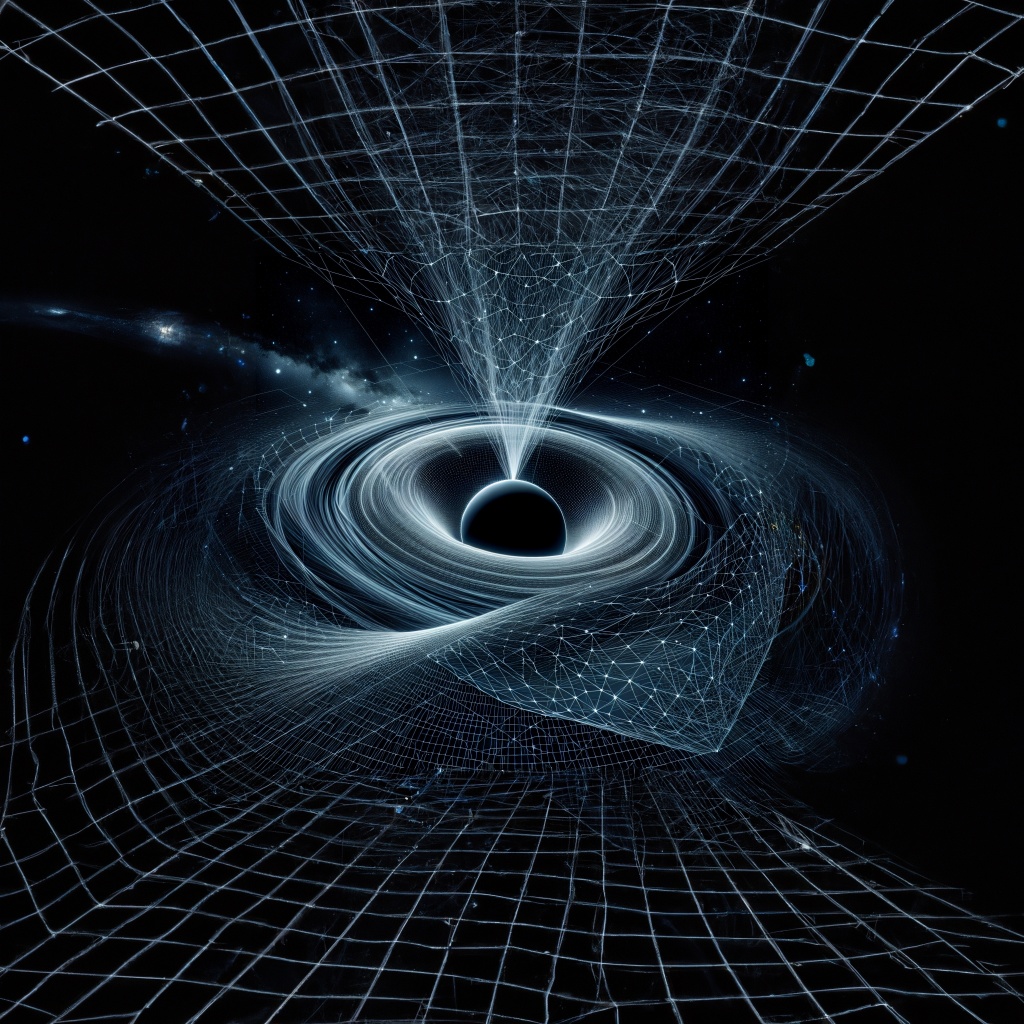
Superfact 15: A black hole is a region of spacetime wherein gravity is so strong that nothing can escape it, not light, not anything. There are different kinds of black holes. We don’t fully understand black holes, which makes them very interesting to science. The boundary of no escape is called the event horizon. Black holes are invisible. They are truly black. However, we can see what they do to their environment as they consume surrounding matter. Below are some bizarre facts about black holes.
- Time runs much slower closer to a black hole.
- An object falling towards a black hole will become redder, faint, then infrared, then invisible and all its movements and clocks will freeze.
- From the perspective of an outside observer, time appears to stop for someone reaching the event horizon of a black hole. Time will continue for someone falling in.
- At the center of a black hole may lie a gravitational singularity, a region where the spacetime curvature becomes infinite. However, since we cannot peer into a black hole we cannot know.
- The largest known black hole (TON 618) is more than 287 million times more massive than the most massive known star (R136a1).
- If our planet earth collapsed into a black hole, it’s diameter would be 1.75 centimeters or 0.69 inches in diameter. The diameter of the largest known black hole (TON 618) is 242 billion miles, which is more than one million times larger than the distance from the earth to moon.
- There are supermassive black holes located at the center of most large galaxies, including our Milky Way. The Milky Way’s black hole is about 4 million times the mass of the Sun.
- Astronomers estimate that there are around 100 million black holes in our Milky Way.
- When an object (maybe a spaceship, or a person) approaches or falls into a black hole the difference between the gravity on the parts closer to the black hole and those further away will be so large that the object is stretched and ripped apart. This is called spaghettification.
- Stretching from the event horizon and out another half radius of the black hole is a region called the photon sphere. In the photon sphere light will travel in a non-stable circular orbit around the black hole. Light will go around and around for a while. If you are in the photon sphere you might be able to see the back of your head.
- Above is just a small sample of weird black hole facts.

The Bizarre Reality of Black Holes
I chose the Bizarre Reality of Black Holes as a super-fact and included the ten facts above because these facts are shocking and yet not well known. Below is a photograph of a supermassive black hole at the center of the galaxy M87 taken by the event horizon telescope in 2017. To create the picture below image processing was needed. It is the first photograph of a black hole. This supermassive black hole is an estimated 6.5 billion times as massive as our sun, and 28 million times as massive as the largest known star.

Below is an animation created by NASA that depicts what an observer falling into a black hole would see.
The fact that from the perspective of an outside observer, time appears to stop for someone reaching the event horizon of a black hole seems to prevent anything from falling into a black hole from an outside perspective. How does anything ever get inside the black hole if it freezes up at the event horizon? Black holes grow, they collide and merge, so clearly things can get inside, right? But how? As I tried to find the answer to this question, I found that I was far from the only one asking this question.

I searched physics forums trying to find the answer to this question. There were a lot of discussions but no clear answers. Some said, nothing falls into a black hole. Everything accumulates on the event horizon from the outside perspective and that’s how the event horizon and the black hole grows. The observer crossing the horizon essentially jumps infinitely far into the future, or into a different universe, that’s how he can pass through the event horizon.
Others said that the black hole is not static, it grows, and it shrinks from Hawking radiation, and this complicates the equations so that objects can enter the black hole even from an outside perspective. I have a few physics books on black holes that I have not finished reading. If I learn something better, I will update this post.

In the image above the grid demonstrates how a black hole is distorting space-time. Other strange facts about black holes are that they are slowly evaporating through what is called Hawking radiation.
They come in different sizes. The smallest known black hole (XTE J1650-500) has a diameter of approximately 15 miles. Perhaps scariest of all, black holes are nearly undetectable unless they are feeding on star dust or tugging on nearby stars. That means one hungry black hole could be zipping right through our solar system without us knowing. Considering there are an estimated 100 million black holes in our Milky Way space travel might be scary.
Addressing a Good Question
After posting this post I received a question via email regarding this fact “If our planet earth collapsed into a black hole, its diameter would be 1.75 centimeters or 0.69 inches in diameter. The diameter of the largest known black hole (TON 618) is 242 billion miles, which is more than one million times larger than the distance from the earth to moon.” The person who asked thought that 1.75 centimeters was pretty tiny and was wondering how a black hole could be that small.
To create a black hole, you need extremely strong gravity and one way to increase the force of gravity at the surface of a planet is to compress all its mass into a smaller volume.
If you compressed all of earth’s gravity so its diameter was only half of what it is, it would be more compact, and the gravity would be four times stronger at earth’s surface. If you compressed it further so that the earth’s diameter would only be a fourth of its original diameter the gravity at the surface would now be 16 times stronger. If you keep compressing the earth until its diameter is only 1.75 centimeters the force of gravity at the surface would be 132,000 trillion times greater than it currently is according to Newtonian physics, and you would get a black hole.
I should say that it comes out differently with General Relativity and that number is different for different sized black holes. However, this calculation is for demonstrative purposes. For relatively small masses like a planet, you would have to compress so much that it becomes tiny before gravity becomes large enough to make a black hole.
To see the other Super Facts click here
If you were an astronaut on an interstellar journey, would you be afraid of falling into a black hole?


Black holes are fascinating. Spaghettification is a new phenomenon to me, but I was surprised to discover how many black hole facts were crammed in my brain. And none I can use in my writing. Great post, Thomas.
LikeLiked by 2 people
Yes I certainly agree. I am not surprised you already knew a lot of these. Thank you so much Patricia.
LikeLiked by 1 person
Congratulations on reaching number 50, Thomas! That’s impressive.
If you ever need a topic, I was just thinking about nuclear power today because the tech companies are talking about building their own reactors. I’m not a big fan but I have heard that the new ones are safer than they used to be and wondered that the super-factual truth might be. Best, Ben
Bennett Voylesbennettvoyles.de Tel. +49 151 62967276 Winterfeldtstr. 39 10781 Berlin, Germany
LikeLiked by 2 people
Thank you so much Ben. I haven’t done 50 yet. That is just my 50-first plan. I’ve only done 15 out of those 50. I am going a bit slow. However, I also made about a dozen posts that are not superfacts but just what I think are interesting fact related posts. I think your suggestion about nuclear power is an interesting one. I am going to research it and find a super-fact to put it on my list. I hope you and Cybele and the children are doing well.
LikeLike
Fascinating, indeed! Thanks for sharing, Thomas! Much appreciated! Light and blessings*
LikeLiked by 2 people
Thank you so much Susana and light and blessings to you
LikeLiked by 1 person
An interesting topic. I have always had a fascination with black holes. Great for story telling too 😉🌝
LikeLiked by 2 people
Yes I agree, they are fascinating objects and I think good for story telling too. Since we cannot truly know what is inside a black hole, if anything, you can just make that up in a story.
LikeLike
Yes, it is a fabulous concept 💫
LikeLiked by 1 person
Jack Van Impe, the controversial end of times tele evangelist, won an Ig Nobel Prize in 2001 for astrophysics, for his theory that inside a black hole is where hell is. The Ig Nobel Prize is sort of a satirical nobel prize. It is given for funny research, often to real scientists.
One zoologist got the Ig nobel price for collecting whale snout for her research using helicopters flying over whales in the ocean. When they resurfaced she came down with her helicopter to collect the whale snout.
LikeLike
Hell inside a black hole? JEEZ, and all this time I thought it my last job. But that’s another story.
At least the zoologist had something to show for her work.
LikeLiked by 1 person
I suppose a black hole could easily fit the definition of hell. Did the whales die when their snouts were removed? Sounds horrible.
LikeLiked by 1 person
LOL. I am sorry you had such a hellish job Denise. You are right, the zoologist had something to show for her work. Not all of the Ig Nobel Prizes are nonsense, just strange and funny research, some that is entertaining to read about. Other examples are:
Physiology: Takanori Takebe, for finding that several mammals can breathe through their anus.
Chemistry – Ivette Bassa, the synthesis of bright blue Jell-O
Medicine: Lieven Schenk, Tahmine Fadai and Christian Büchel, for finding that fake medicine that induces painful side-effects can be more effective than fake medicine that does not cause painful side-effects
Demography: Saul Justin Newman, for finding that supercentenarians and extreme age records tend to come from areas with no birth certificates, rampant clerical errors, pension fraud, and short life spans
Economics – Michael Milken, titan of Wall Street and father of the junk bond
Literature – Erich von Däniken, visionary raconteur and author of Chariots of the Gods?, for explaining how human civilization was influenced by ancient astronauts from outer space.
Peace – Edward Teller, father of the hydrogen bomb and first champion of the Star Wars weapons system, for his lifelong efforts to change the meaning of peace as it is known.
LikeLiked by 1 person
Fascinating, Thomas. This is especially interesting: Medicine: Lieven Schenk, Tahmine Fadai and Christian Büchel, for finding that fake medicine that induces painful side-effects can be more effective than fake medicine that does not cause painful side-effects
LikeLiked by 1 person
No sorry Robbie, I was not clear, the snouts were not removed. She collected the snout from the snouts, in little containers, like the doctor taking a sample from your nose.
LikeLike
Ah, that creates a much better image in my mind 💓
LikeLiked by 1 person
If she had removed the snouts I doubt even the Ig Nobel Prize would have given it to her. Luckily it was not that bad.
LikeLike
Yes, that is why I was a mystified. Sometimes my imagination runs away with me, Thomas.
LikeLiked by 1 person
Yes I think you are right Robbie. By the way the comments are messed up somehow. The replies are not ending up in the right place.
LikeLike
Oh dear, sorry about that. I pick them up through the reader so it doesn’t effect me.
LikeLiked by 1 person
Robbie as a naturalist you are aware of a lot of cruelty towards animals. It is not strange you would think that.
LikeLike
I am aware of a lot of cruelty and it breaks my heart. Hugs
LikeLiked by 1 person
NASA’s simulation was amazing–but I’m still confused! Sigh. They are complicated events.
LikeLiked by 2 people
I agree on both, fascinating simulation but can you actually get inside? I have not found a clear answer to that question. Many opinions but nothing conclusive. I asked ChatGPT, which essentially said no. Viewed from the outside, the rest of the Universe if you will, nothing can get inside a black hole. However, ask the question a bit differently and it contradicts itself. Not even ChatGPT knows.
LikeLiked by 1 person
I wonder Thomas, if NASA could fill our £22 Billion Black HOLE in our Public Finances .. Haha…,,, Sorry I just had to say that as our Newly elected Government are repeatedly throwing that down our throats so they can fleece us with more Tax…
On a more serious note…. Thank you for all the information you shared… And it is remarkable to think of these anomalies in outer space ,, xx
LikeLiked by 2 people
Yes I read that the previous UK government overspent 22 billion pounds. I know someone else who did that, but you can just put it on a credit card. Just kidding….Anyway, black holes are indeed very extreme and strange objects, which makes them fascinating and shocking as you think about them. Thank you so much for your kind words Sue.
LikeLiked by 1 person
🙂 you are most welcome
LikeLiked by 1 person
Lulu: “Our Dada says when he was a kid he enjoyed the Disney movie The Black Hole, but he suspects it was shall we say lacking in scientific accuracy.”
Java Bean: “Nooooo!”
Lulu: “Sad but true.”
Oona: “Happy Halloween!”
LikeLiked by 2 people
Ha ha they are funny the doggies. Thank you all for stopping by and Happy belated Halloween to you.
LikeLike
I’m replying out of sequence. Oh, man what a list of Ig Noble prizes!
LikeLiked by 2 people
It is a fun concept. It was not created to insult people but to have a little fun with funny research. Some of the stuff is useful, but funny.
LikeLiked by 1 person
Thanks for the intriguing post about one of the wildest objects in the universe. I’m far from a black hole expert, but the picture I have from my (admittedly long ago) general relativity class is that material can indeed fall onto the black hole, it’s just that information (i.e. light) is also pulled inside, so you can’t observe it. Now, where exactly is the “surface” that you crash into? That’s a very good good question. There is, presumably, some tiny “nugget” of matter in the center of warped spacetime, but do things ever make it that far or do they get torn apart closer to the event horizon and stay frozen there? I don’t think anyone knows the answer to that.
LikeLiked by 2 people
Thank you so much David. That is very interesting information. I took classes that included special relativity (also a long time ago) but not general relativity. The tensor calculus seems kind of scary. But I am wondering if I should try to dive into it. I would like to find out what is known about this issue.
LikeLiked by 1 person
As I say, my class was a long time ago, but I remember it being very fascinating. The tensor calculus was tricky at first, but I soon got the hang of it.
Black hole science has certainly come a long way in the last 40 years. I wouldn’t be surprised if my understanding is outdated, but even in the case of an ordinary black hole, you’re talking about an object with a mass equivalent to several times that of the sun compressed as close as possible to the size of a mathematical point. Whatever that is is going to be very exotic matter that has a really strong effect on its local spacetime.
LikeLiked by 1 person
It is frightening to think about what might be inside if there is an inside. I have a half dozen books on General Relativity ranging from General Relativity without Calculus (José Natario), A first course in general relativity by Bernard E. Schutz, General Relativity by Robert M. Wald, a few more, and Gravitation by Misner Thorne and Wheeler, the latter which I will never read. I am hoping to read a few of those in the future, just as a retirement project. But I’ll start with the easiest one. I also have some books on black holes of varying difficulty. Thank you so much for the interesting information David.
LikeLiked by 1 person
Just to note, Gravitation by Misner, Thorne, and Wheeler was one of my textbooks in the General Relativity class I took.
LikeLiked by 1 person
Holy cow! Considering the enormous weight and size of that tome and the abstract math in it I am surprised it does not create a black hole all by itself. I realized when I got it from Amazon that I would never read it but I decided to keep it anyway. I put it on the bottom shelf. It stabilizes my book shelf and might have kept my house from blowing away when the tornado hit our neighborhood. Anyway, that must have been a very challenging class.
LikeLiked by 1 person
It was a challenging class and I’m grateful for the “B” I earned. My graduate advisor was the guy who predicted that a neutrino burst would precede a supernova explosion. He described my professor as one of the handful of people he knew at the time who really understood the subject well enough to teach it. (Kip Thorne, incidentally, was one of the other people he named who could do the job.)
LikeLiked by 1 person
It sounds like an extremely challenging class. It sounds like a real deep dive. I am glad you survived. Your “graduate advisor was the guy who predicted that a neutrino burst would precede a supernova explosion”. That is very cool. Wasn’t there a nobel prize involved in that?
LikeLiked by 1 person
Unfortunately no Nobel for his work on neutrinos from supernovae. His name was Stirling Colgate, by the way. He did get a lot of press for his theoretical work when Supernova 1987A went off, though, and was featured in an episode of the PBS series, Nova.
LikeLiked by 1 person
I did recognize his name and I just looked him up. It is very impressive that he was your advisor.
LikeLiked by 1 person
Very helpful, Thomas. Thank you for diving deep into this fascinating topic.
LikeLiked by 1 person
Thank you so much Gwen. I appreciate your kind comments.
LikeLike
more things to worry about lol. did you ever watch Twilight Zone? The episode where the little girl gets lost in a black hole in her closet? siri says black holes were discovered in 1971 but the tv episode was made in 1962, from a sci fi story from early 50’s…
LikeLiked by 1 person
I did not see that Twilight episode but I saw some other Twilight episodes. A black hole in your closet is certainly an upgrade from a monster in the closet. Black holes has a long history. Already in 1783 John Michell suggested that some stars could have such a strong gravity that light could not escape. He called them dark stars. That is quite different from our modern concept of black holes, but it is still a first step. Then in 1915 Albert Einstein created the General Theory of Relativity, which predicted the existence of real black holes, or the modern concept of black holes bending space and time and an event horizon, etc. At first Albert Einstein did not realize that his theory predicted this. That was Karl Schwarzschild a year later, in 1916. Einstein did not like this and he tried to find a way so that his theory would not predict such monsters. In 1939 Robert Oppenheimer, the father of the atomic bomb, showed that massive stars (at least 3 times more massive than our sun) would collapse into a black hole. In 1971 the first stellar black hole, Cygnus X-1, was discovered. We went from theory to practice. So that is probably what Siri was talking about.
The concept of black holes existed long before 1971 but in 1971 was the first confirmed existence of one. It is often that way. Wolfgang Pauli predicted in 1930 that a particle called the neutrino must exist but no one had seen one. It took until 1956 before the first neutrino was detected.
LikeLiked by 1 person
And then there are wormholes…
LikeLiked by 1 person
Yes wormholes such as Einstein–Rosen bridges and Schwarzschild wormholes, also derived from General Theory of Relativity the year after (1916). General Relativity spawned some curious things. Unlike black holes though, none has ever been found.
LikeLiked by 1 person
This is a fascinating subject, Thomas, and I enjoyed the video. Intriguing that a televangelist would declare hell was located at the centre of a black hole! I recall some instances of black holes from Star Trek, and that’s the extent of my knowledge on the topic. 😳
https://www.startrek.com/en-ca/news/darkest-treks-closest-calls-with-black-holes
LikeLiked by 1 person
Thank you Debbie. I think it is a fascinating topic too and thank you for the interesting article. I have a lot to learn about this topic but I don’t feel bad, so does the astronomers/astro-physicists themselves.
LikeLiked by 1 person